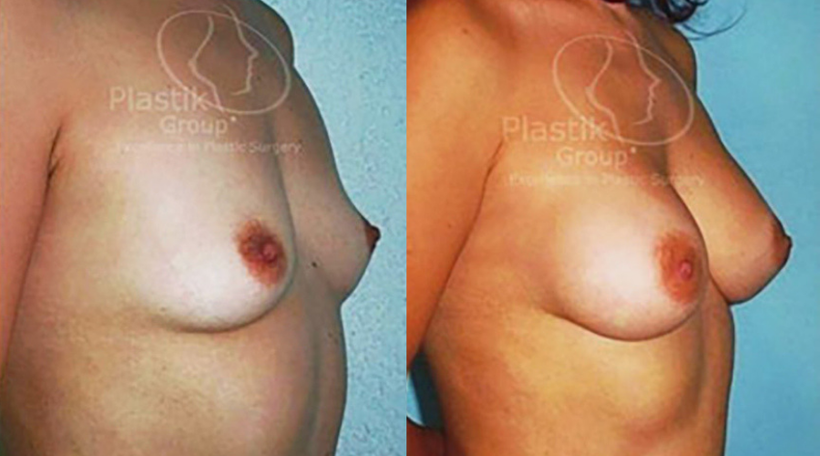Breast Augmentation
Augmentation

AUGMENTATION MAMMOPLASTY or BREAST IMPLANTS (Breast Augmentation)
This is a surgical procedure to enhance the size and shape of a woman breast for a number of reasons:
- To enhance the body contour of a woman who, for personal reasons, feels her breast size is too small.
- To correct a reduction in breast volume after pregnancy.
- To balance a difference in breast size.
- As a reconstructive technique following breast surgery.
By inserting and implant behind each breast, we are able to increase a woman’s bustline by one or more bra cup sizes. The final size depends on the expectations of the patient, and the surgeon´s advice.
The following information is strictly the opinion of Dr. Gomez-Mendoza and pertains to augmentation mammoplasty procedure as performed by him.
If you’re considering breast augmentation, this information will help provide a basic understanding of what an augmentation mammoplasty can and cannot achieve. Because each individual patient is different no amount of written information can replace a personal consultation with Dr. Gomez-Mendoza and his team.
Candidates for Augmentation Mammoplasty
The best candidates for breast augmentation are women who are looking for improvement in the way they look. If you are physically healthy and realistic in your expectations, you may be a good candidate.
Breast augmentation is relatively straightforward, but the more common problem, capsular contracture, occurs if the scar or capsule around the implant begins to tighten. This squeezing of the soft implant can cause the breast to feel hard. Capsular contracture can be treated in several ways, and sometimes requires either removal or “scoring” of the scar tissue, or perhaps removal or replacement of the implant.
There is no evidence that breast implants will affect fertility, pregnancy, or your ability to nurse. If, however, you have nursed a baby within the year before augmentation, you may produce milk for a few days after surgery. This may cause some discomfort, but can be treated with medication prescribed by us.
Occasionally, breast implants may break or leak. Rupture can occur as a result of injury or even from normal compression and movement of your breast and implant, causing the man-made shell to leak. If a saline-filled implant breaks, the implant will deflate in a few hours and the salt water will be harmlessly absorbed by the body.
If a break occurs in a cohesive gel-filled implant, however, one of two things may occur. If the shell breaks but the scar capsule around the implant does not, you may not detect any change. If the scar also breaks or tears, especially following extreme pressure like in a car accident, cohesive gel may move into surrounding tissue causing a new scar to form around it. There may be a change in the shape or firmness of the breast. Both types of break may require a second operation and replacement of the leaking implant.
Planning your surgery
In your initial consultation, Dr. Gomez-Mendoza and his team will evaluate your health and examine your breasts and measure them while you are sitting or standing, then we will discuss the variables that may affect the procedure (such as your age, the size and shape of your breasts, and the condition of your skin) and explain which surgical techniques are most appropriate for you. If your breasts are sagging, we may recommend also a Mastopexy (breast lift)
Preparing for your surgery
Depending on your age and family history, we may require you to have a mammogram (breast x-ray) before surgery. You will also get specific instructions on how to prepare for surgery, including guidelines on eating and drinking, smoking and taking or avoiding certain vitamins and medications.
Breast augmentation it is usually done on an outpatient basis, in some cases the patient will be admitted to the hospital as an inpatient, if so you can expect to stay one day.
If you smoke, plan to quit at least one to two Weeks before your surgery and not to resume for at least four weeks after your surgery.
Carefully following these instructions will help your surgery go more smoothly. In addition, we will also be available to answer any questions you might have or any concerns that arise. Please don't hesitate to call us.
What type of anesthesia is used?
Dr. Gomez-Mendoza performs most augmentation mammoplasties, except, endoscopic assisted breast augmentations; under sedation (gentle, short-acting medication administered by a board certified anesthesiologist to insure comfort and security for our patients) and local anesthesia. Patients are under monitored anesthesia care since they arrive to the operating room till they leave the recovery area. You will receive the safest care possible. The expert care you deserve.
Our patients recover more quickly and with less discomfort than when general anesthesia is used.
Where will your augmentation mammoplasty be performed?
Dr. Gomez-Mendoza performs most breast augmentations at the modern Puerta de Hierro Medical Center. Whether you choose to have your procedure done in the peaceful seclusion of our state-of-the-art Medical Center or at one of the many Guadalajara or Puerto Vallarta-area hospitals where we currently enjoy operating privileges; rest assured that you will receive the finest care available.
The surgery
The surgery itself usually takes one and a half to two and a half hours. The method of inserting and positioning your implant will depend on your anatomy and your surgeon’s recommendation. The incision can be made periareolar (through the nipple), inframammary (in the crease under the breast), transaxillary or transumbilical (endoscopic assisted breast augmentation). The positioning of the implant may be subglandular (behind the breast tissue) or subpectoral (behind the pectoralis major muscle). During this surgery asymmetries, shape and size of the areola and other breast defects may be corrected as part of your breast augmentation. Finally, the incisions will be stitched (we only use absorbable sutures placed in an intradermal running fashion so you will not see them and they do not need to be removed). This technique obviates the need for external skin sutures and circumvents the possibility of suture marks.
After your surgery
You will wear a support bra over your gauze dressings. Your breasts will be bruised, swollen and uncomfortable for a day or two, but the pain should be mild. Any discomfort you do feel can be relieved with your medications. You will wear the bra around the clock for four weeks. The stitches will be absorbed and they are located intradermically so you will not see them.
If your breast skin is dry following surgery, you can apply a moisturizer several times a day. Be careful not to tug at your skin in the process, and keep the moisturizer away from the incision areas.
You can expect some loss of feeling in your nipples and breast skin, caused by the swelling surgery. This numbness usually fades as the swelling subsides over the next two to four weeks.
Healing is a gradual process. Although you may be up and about in a few hours, don’t plan on returning to work for a week. And avoid lifting anything over your head for three weeks.
You will be instructed to avoid sex for two weeks and to avoid strenuous sports for about a month.
If you become pregnant, the operation will not affect your ability to breast-feed.
Your new look
Although much of the swelling and bruising will disappear in the first few weeks, it may take three to six months before your breasts settle into their new shape. Even then, their shape may fluctuate in response to your hormonal shifts, weight changes, and pregnancy. We will make every effort to make your scars as inconspicuous as possible, it is important to remember scars are permanent and your scars may actually appear to worsen during the first two to three months as they heal, but this is normal. Expect it to take six to nine months before your scars flatten out and lighten in color.
Are there any risks?
When an augmentation mammoplasty is performed by a qualified plastic surgeon certified by the Board of Plastic Surgery, complications are infrequent and usually minor.
While Dr. Gomez-Mendoza and his team make every effort to minimize risk, individuals vary greatly in their anatomy, their healing ability as well as in their reactions to surgery and anesthesia. Complications that may occur include minor haematoma (a small collection of blood beneath the skin), infection, capsular contracture, poor healing and reactions to medications. You can reduce your risks by closely following the advice of your surgeon concerning your pre-operative and post-operative care. There are not risk free surgical procedures.
To contact plastic surgeon Dr. Jesús Gómez Mendoza about any cosmetic surgery procedures, please fill out our contact form or call us at (+52 (33) 3848-5477

